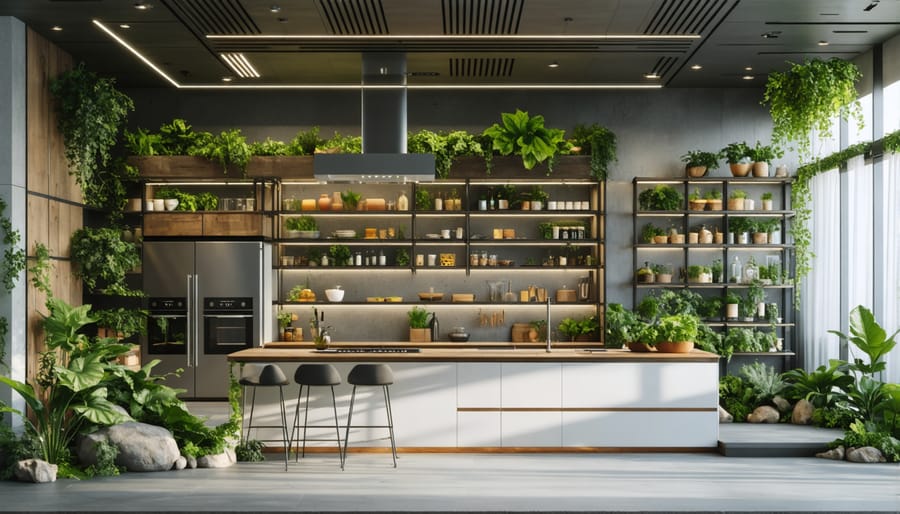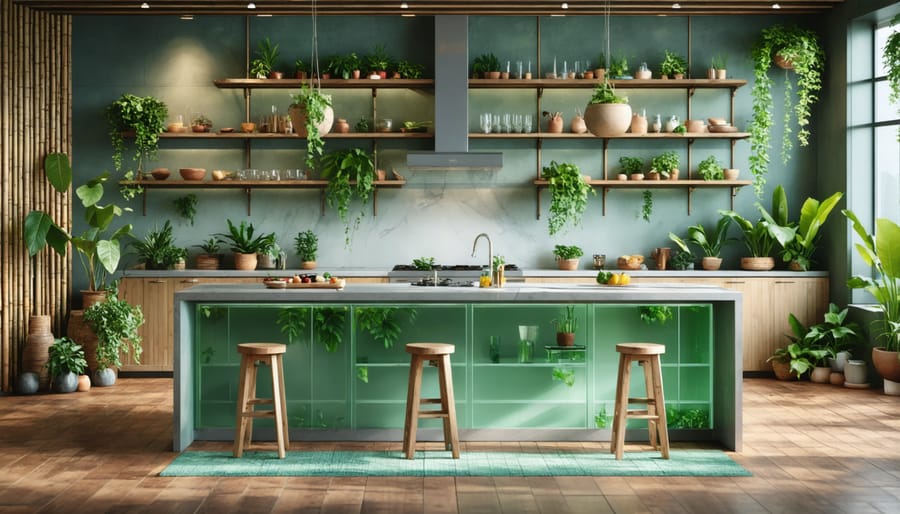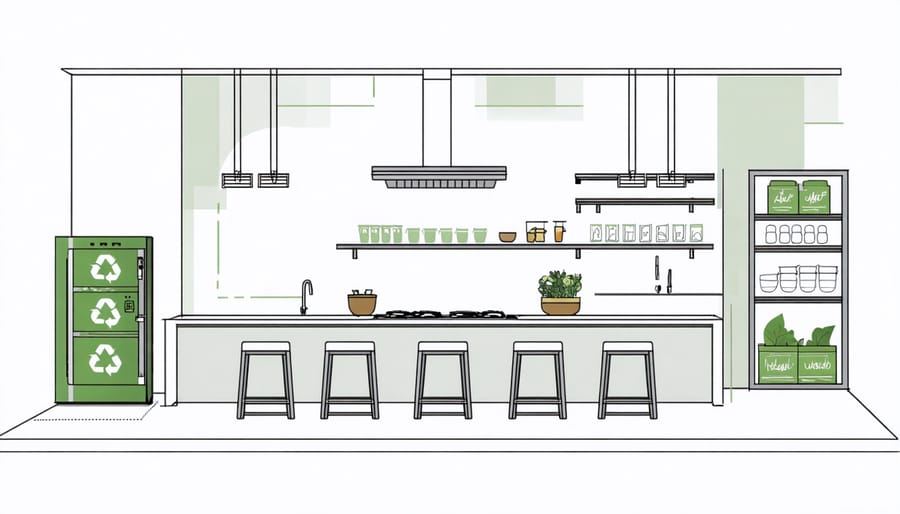Sustainable interior design transforms living spaces into eco-conscious sanctuaries without sacrificing style or comfort. By mindfully selecting renewable materials, maximizing natural light, and incorporating energy-efficient solutions, designers create spaces that benefit both the environment and their occupants. Today’s sustainable design goes beyond simple recycling, embracing a holistic approach that considers a product’s entire lifecycle – from raw material sourcing to eventual disposal. This thoughtful methodology not only reduces environmental impact but often results in healthier indoor environments and lower utility costs.
Modern sustainable interiors masterfully blend timeless aesthetics with responsible materials like reclaimed wood, recycled metals, and low-VOC finishes. Smart space planning optimizes natural ventilation and daylight, while energy-efficient appliances and water-saving fixtures seamlessly integrate into beautiful, functional designs. The result? Spaces that feel both luxurious and responsible, proving that environmental consciousness and sophisticated design can coexist beautifully.
Whether renovating or starting fresh, sustainable interior design offers a pathway to create spaces that look stunning today while protecting tomorrow’s resources. This approach isn’t just a trend – it’s a fundamental shift in how we think about creating beautiful, responsible living environments.
What Makes a Kitchen Design Truly Sustainable?
Energy Efficiency at Its Core
At the heart of sustainable interior design lies energy-efficient home design, which combines smart technology with thoughtful planning to reduce your environmental footprint. Start by choosing Energy Star-certified appliances, which can significantly lower your utility bills while maintaining excellent performance. LED lighting fixtures not only last longer but consume up to 75% less energy than traditional bulbs, making them a brilliant choice for any room.
Consider incorporating natural light through strategically placed windows and skylights, reducing the need for artificial lighting during daylight hours. Installing programmable thermostats and smart climate control systems helps maintain comfortable temperatures while minimizing energy waste. Window treatments like cellular shades or thermal curtains provide additional insulation, keeping your space cooler in summer and warmer in winter.
Don’t overlook the power of proper ventilation and ceiling fans – they can dramatically reduce your reliance on heating and cooling systems. By combining these energy-efficient elements with smart home automation, you’ll create a space that’s both comfortable and environmentally responsible.

Water Conservation Features
Water conservation is a cornerstone of sustainable interior design, offering both environmental benefits and cost savings. Modern water-saving home solutions make it easier than ever to create an eco-friendly space without sacrificing style or functionality.
Start with dual-flush toilets and low-flow faucet aerators in bathrooms and kitchens, which can reduce water usage by up to 50% compared to traditional fixtures. Motion-sensor faucets add a touch of luxury while preventing unnecessary water waste. Consider installing a tankless water heater, which provides hot water on demand and eliminates standby energy losses.
For a more comprehensive approach, integrate a greywater system that recycles water from sinks and showers for toilet flushing or garden irrigation. Smart water meters can help track usage and detect leaks early, while water-efficient appliances like dishwashers and washing machines complement these features perfectly.
When selecting fixtures, look for WaterSense certification – it’s like ENERGY STAR for water efficiency. These products are independently certified to use at least 20% less water while maintaining excellent performance.
Sustainable Materials for Your Dream Kitchen

Renewable and Recycled Materials
When it comes to creating a sustainable interior, choosing the right eco-friendly building materials is essential. Bamboo has become a designer favorite, thanks to its rapid growth rate and versatility. This renewable resource can be used for flooring, furniture, and decorative elements, offering both durability and style while maintaining a minimal environmental footprint.
Reclaimed wood tells a unique story in every piece while preventing deforestation. Whether it’s barn wood transformed into statement wall panels or old timber crafted into dining tables, these materials bring character and sustainability to your space. Plus, the natural patina and wear patterns add an irreplaceable charm that new materials simply can’t match.
Recycled glass is another stunning option that’s gaining popularity in sustainable design. From colorful countertops to decorative tiles, these materials give new life to what would otherwise end up in landfills. They’re not only environmentally conscious but also create beautiful, light-catching surfaces that can brighten any room.
Other sustainable choices include cork flooring, which is harvested without harming trees, and recycled metal fixtures that add industrial charm while reducing waste. Natural fibers like organic cotton, hemp, and jute offer eco-friendly options for textiles and rugs, while recycled plastic materials are being transformed into everything from outdoor furniture to innovative wall coverings.
Low-Impact Finishes and Coatings
When it comes to creating a truly sustainable interior, the finishes and coatings you choose play a crucial role in both environmental impact and indoor air quality. Opting for non-toxic finishes isn’t just better for the planet – it’s essential for creating a healthier living space for you and your family.
Look for water-based paints labeled as zero or low-VOC (Volatile Organic Compounds), which release fewer harmful chemicals into the air. These modern formulations offer excellent coverage and durability while being gentler on the environment. Natural paint options made from milk protein, clay, or plant-based materials are also gaining popularity for their minimal environmental impact and beautiful finish qualities.
When it comes to wood finishes and sealants, consider products made from natural oils like linseed, tung, or hemp. These alternatives provide beautiful protection while being biodegradable and renewable. For concrete sealing or floor finishing, opt for water-based polyurethanes or natural waxes instead of traditional solvent-based products.
Many eco-friendly finishes now come in a wide range of colors and textures, proving that you don’t have to sacrifice style for sustainability. Remember to properly dispose of any leftover products and containers through local hazardous waste facilities to complete the sustainable lifecycle of these materials.
Smart Space Planning for Sustainability
Smart space planning is at the heart of sustainable interior design, going far beyond just making rooms look good. When we thoughtfully organize our living spaces, we naturally reduce our environmental footprint while creating more functional, enjoyable homes.
Start by analyzing how you actually use your space. Consider traffic patterns, daily routines, and activities that happen in each room. This understanding helps you design layouts that minimize wasted space and maximize efficiency. For instance, creating multi-functional areas – like a home office that doubles as a guest room – reduces the need for additional rooms and their associated resource consumption.
Storage solutions play a crucial role in sustainable design. Built-in shelving and custom storage units, while requiring an initial investment, can significantly reduce the need for disposable organizing products over time. Look for vertical storage opportunities to make the most of available wall space, and consider furniture pieces that serve dual purposes, such as ottoman storage benches or murphy beds.
Natural light is your best friend in sustainable space planning. Position furniture and storage solutions to maximize daylight penetration, reducing the need for artificial lighting during daytime hours. Consider using glass panels or translucent room dividers when you need to separate spaces, allowing light to flow through freely.
Here are some practical tips for sustainable space planning:
– Create zones based on activity patterns to minimize energy waste
– Install modular storage systems that can adapt as your needs change
– Use corner spaces effectively with custom solutions
– Incorporate flexible furniture that can serve multiple purposes
– Plan room layouts to optimize natural ventilation
Remember, efficient space planning isn’t just about fitting more into less space – it’s about creating thoughtful environments that reduce resource consumption while enhancing your daily life. When every square foot serves a purpose, you naturally minimize waste and create a more sustainable home.

Waste Reduction Through Design
When it comes to sustainable interior design, waste reduction through thoughtful design choices plays a crucial role in creating eco-friendly spaces. Start by embracing the “design for disassembly” principle, where furniture and fixtures can be easily taken apart for repair, recycling, or repurposing. This approach not only extends the life of your design elements but also ensures materials can be properly recycled when needed.
Consider incorporating built-in recycling solutions that blend seamlessly with your interior design. Multi-bin systems hidden in kitchen cabinets or stylish sorting stations in utility areas make responsible waste management both convenient and aesthetically pleasing. Smart storage solutions can also help reduce waste by keeping items organized and visible, preventing unnecessary purchases and reducing the likelihood of items being forgotten and discarded.
Choose materials and products with minimal packaging or those that use recycled or biodegradable packaging. When selecting furniture and decor, opt for pieces made from recycled materials or those that can be easily recycled at the end of their life cycle. Look for manufacturers who have take-back programs or offer repair services to extend product lifespans.
Space planning also plays a vital role in waste reduction. Design rooms with flexibility in mind, allowing spaces to adapt to changing needs without requiring complete renovations. Use modular furniture and versatile design elements that can be reconfigured rather than replaced as your needs evolve.
Finally, consider implementing a materials library in your design process, keeping track of leftover materials from previous projects that can be repurposed in future designs. This approach not only reduces waste but also adds character to your spaces through creative reuse.
Embracing sustainable interior design isn’t just a trend – it’s a meaningful way to create beautiful spaces while protecting our planet for future generations. Throughout this guide, we’ve explored how thoughtful material choices, energy-efficient solutions, and eco-friendly practices can transform your home into a stylish, environmentally conscious sanctuary.
Remember that sustainable design doesn’t require an all-or-nothing approach. Start small by incorporating natural materials, choosing energy-efficient lighting, or opting for secondhand furniture. As you become more comfortable with sustainable choices, you can gradually expand your eco-friendly design elements throughout your home.
The benefits of sustainable interior design extend far beyond environmental impact. You’ll likely notice improved indoor air quality, reduced energy bills, and a deeper connection to your living space. Plus, many sustainable design choices add long-term value to your home while creating a healthier environment for you and your family.
Whether you’re planning a complete home renovation or simply refreshing a single room, consider how you can incorporate these sustainable design principles into your next project. Every environmentally conscious choice, no matter how small, contributes to a more sustainable future. Let your creativity flow as you design spaces that are both beautiful and responsible – your home and the planet will thank you for it.
